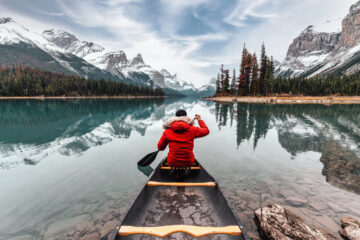Everest Base Camp Trek – The Ultimate Guide

By Suman Aryal Rijan December 04, 2022
If you are planning a trek to Everest Base Camp, you will need to prepare your gear. This article will tell you what to bring and what not to bring, as well as the weather in Everest Base Camp and how to get there from Kathmandu. We’ll also discuss what to pack for the trek, and when is the best time to go.
Best time to trek to Everest Base Camp
If you want to trek to Everest Base Camp in the Himalayas but want to avoid the crowds, the best time to go is May. May is one of the best months to trek to EBC, and the weather is pleasant and clear throughout the day. The temperatures in May are around fifteen degrees Celsius, which is the optimum temperature for trekking.
Fall is also a great time to go to Everest Base Camp because the bird population is at its highest. During autumn, you can see migratory birds that are returning to lower elevations before winter. You can also attend fall harvest festivals, where Buddhist monks and Sherpas gather in celebration of the harvest season. While autumn is considered the peak season for trekking to Everest Base Camp, its benefits are often outweighed by the crowds.
Additionally, the best time to trek to Everest Base Camp depends on what activities you want to do. If you plan to take helicopter tours to the summit, you should go during the non-monsoon season. However, you can also go during winter, when the weather is cold but you will enjoy clear mountain views.
While late October and early November are the busiest months, there are also some good times. During this time, the monsoon season is over and temperatures don’t dip too low. However, you may encounter some snow showers during this time, which can make the trek more challenging.
During the summer months, many experienced climbers will attempt to reach the summit of Everest. But you should avoid climbing Everest in late May because the visibility is limited. Late May can also result in snowfall, and nighttimes can be cold. On sunny days, you can enjoy the hike in warmer weather.
Weather conditions at Everest Base Camp
The weather at Everest Base Camp can vary significantly depending on the time of year. From late December to early March, temperatures can drop as low as -12 degC at night. During the day, temperatures remain moderate, averaging 10 to 15 degC. At night, winds can gust up to 38 km/h. The best time to visit Everest Base Camp is during the early spring season, when temperatures are more pleasant. The sun is often out and temperatures are still comfortable for trekking and sightseeing.
Although temperatures at Everest Base Camp are usually comfortable, temperatures can fluctuate widely. You should plan your trip accordingly to avoid extreme weather. On average, temperatures in Everest Base Camp remain below freezing throughout the year. Biting Himalayan winds can make temperatures feel even colder. On clear days, temperatures can drop below zero. It is also warmest during the rainy season, which falls during July and August. The best time to visit Everest Base Camp is between April and May, when temperatures do not rise as high as during the summer months.
During winter, the weather at Everest Base Camp can be cold and wet. Temperatures can drop as low as -40 degree C. You should dress accordingly if you plan to hike to Everest Base Camp during this season..
Mid-spring weather is best to visit Everest Base Camp in April or May when temperatures stay around twenty degrees. During this time, temperatures are more favorable with less rain and snow. The days are also longer and sunny, which is a plus for trekkers.
Getting to Everest Base Camp from Kathmandu
One of the best ways to reach Everest Base Camp is to fly from Kathmandu to Lukla, the capital of the Everest area. You can spend five or seven days at the base camp after landing. You can stay in a simple lodge or go on a camping tour. It’s best to take your time, and plan your itinerary accordingly.
The first stop on the Everest Base Camp trail is Phakding, a small village located next to the milky white Dudh Kosi River. This picturesque spot is a photographer’s paradise. It’s dotted with prayer wheels, Mani stones, and rustling flags. The village is also home to a cultural center and museum, which contains rare Buddhist texts.
Many travelers choose to fly to Lukla from Kathmandu. This flight takes about thirty to forty-five minutes, and en route, you will pass through the beautiful Kathmandu Valley.
From there, you can trek to Jiri, where you can spend a few days acclimatizing. Then, you can start your trek to Everest Base Camp, which will take about twelve days.
The most popular time to go to Everest Base Camp is between the months of March and May. The weather during these months is mostly clear, which allows for beautiful views of nature. The weather is usually warm enough to hike to the base camp without snow, although the coldest days may be the most difficult.
You’ll have the chance to visit the base camp at least twice during your trek. The views and scenery are spectacular and the people are friendly and welcoming. In addition to the incredible scenery, the Everest Base Camp trek offers a unique experience that you won’t soon forget.
Other options for Everest Base Camp trek
While the Everest Base Camp trek is the most popular route, you can also choose an alternative route to reach the summit of Everest. Other options include the Three Passes Trek, which involves crossing the Cho La pass, Kongma La (18,175), and Renjo La (17,585). Depending on your health and your budget, you can choose a trek that is as easy or as difficult as you’d like.
A second option is the teahouse trek, which includes exploring the culture of the Sherpa people. The trek begins in Dingboche, which is the highest permanently inhabited village in the world. It includes a visit to Kala Patthar, a lookout point at 5,500 meters that offers breathtaking views of Mount Everest. The teahouse trek also allows you to explore Buddhist monasteries and explore the local culture.
A slightly more challenging route is the Everest Base Camp Trek, which is usually reserved for experienced hikers. This route requires multiple days at high altitudes and has a higher risk of snowpacks. This trek is usually held between April and November and requires a lot of physical preparation. However, this option offers you the chance to explore the Khumbu Region, including the Gokyo Lakes and remote Sherpa hill villages.
Other options for Everest Base Camp trek include trekking through the Annapurna region, and the Everest region. The Annapurna region is home to some of the most beautiful teahouses in the world. Teahouses are not just places to drink tea, they are also full-service bed and breakfasts. There are teahouses on
Everest Base Camp that welcome only a small number of guests.
If you are looking for an Everest Base Camp trek that is less crowded and has fewer tourists, you may want to consider doing a peak-climbing expedition, or an adventure trekking adventure instead. These activities are exciting and memorable, and will last a lifetime.
We provide excellent services to our guests and give our best to make their journey a memorable one. Our packages cover spiritual to Everest base camp trek, peak climbing, historical tours and adventurous expeditions in the snow-capped mountains.
sooperarticles.com







No Comment